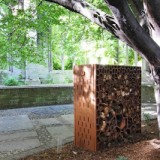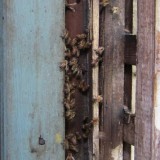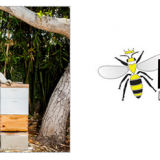
Image: Andrew @ortofarms
The bee swarms of spring makes my inbox overfloweth with requests to remove bees from where they take up residence. Mostly I pass these jobs to a professional, but when a friend or acquaintance calls, and the job does not involve a lot of demolition work or hanging on the end of an extension ladder in a bee suit, I’ll say yes.

The process of removing an established hive involves opening up whatever they are in, cutting out the comb and then scooping up the bees that often will retreat to some out of the way spot. This last part, scooping up the bees, can be time consuming, frustrating and potentially dangerous if the bees are in a cranky mood.

For years I’ve resisted making a bee vacuum with the idea that it’s a crutch, somehow an excuse for bad technique. You can use a smoker to herd bees off the comb and, if you’re careful, once the queen is in the bee box the workers will follow. But if a tool makes things go more smoothly, why not give it a try?

There are a lot of different bee vacs that you can make or buy. I built mine using instructions by P. Michael Henderson. It consists of a box with an inlet for a shop vac and another tube to suck up the bees themselves. It has a removable bottom that you can put on top of another bee box once you’ve finished cutting out the comb and putting it in a box. Then you just remove the false bottom and the bees migrate back to their comb.
This past weekend I, along with my friends Andrew and Stephen, removed some bees from a backyard rotating compost bin (a common place bees like to settle in, by the way). We had to Sawzall the bin apart, unfortunately, and by the time we started removing the comb, most of the bees had settled into a hard to access corner of the bin. With the bee vac, we were able to quickly vacuum up those bees and get them into their new home.

Bee vac on top–box with relocated comb on bottom. Image: Andrew @ortofarms
Then, as usual, with this otherworldly creature, something unexpected happened. A cluster ended up on the pavement of the parking garage at the bottom of the apartment building we were removing them from. Somehow some had gotten smashed on the ground–maybe run over by a car? This attracted other bees. There were a lot of bees in the air too. Thankfully it was a holiday weekend and very few people were home and the bees were not at all aggressive. After pondering what to do in this not great situation, I pulled out the vacuum again and, after a few minutes, we had the rogue clusters vacuumed up and added to the box we wanted them in.
We came back after dark a day later and picked up the box and sent them to Andrew’s farm. I don’t have a lot of hope for this hive as it was very small and not very well established. But for this situation, the bee vac came in handy. Not only were we able to extract the bees from a tight spot but we were able to do so quickly and minimize the chance that they would go after people or pets in a dense urban location.




Nicely done. Can definitely see the utility of the bee vac. We want to believe the bees will re-establish at Andrew’s farm. Please keep us updated.
Love this!